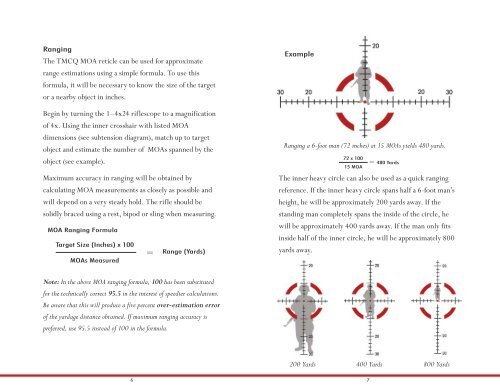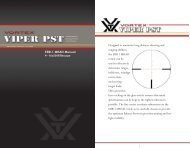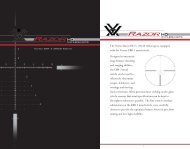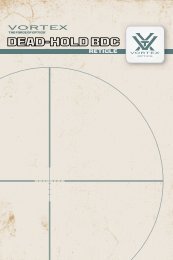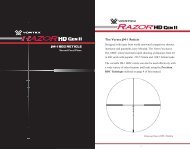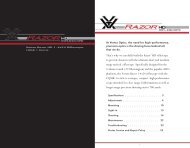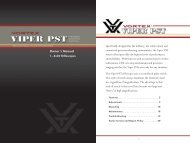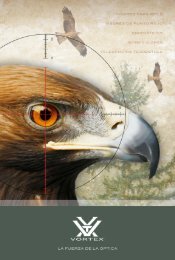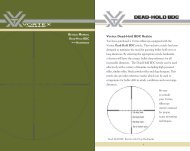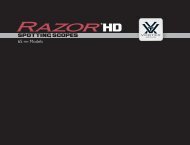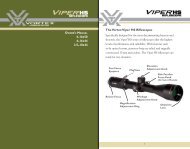Vortex TMCQ MOA reticle manual - EuroOptic.com
Vortex TMCQ MOA reticle manual - EuroOptic.com
Vortex TMCQ MOA reticle manual - EuroOptic.com
Create successful ePaper yourself
Turn your PDF publications into a flip-book with our unique Google optimized e-Paper software.
Ranging<br />
The <strong>TMCQ</strong> <strong>MOA</strong> <strong>reticle</strong> can be used for approximate<br />
range estimations using a simple formula. To use this<br />
formula, it will be necessary to know the size of the target<br />
or a nearby object in inches.<br />
Begin by turning the 1–4x24 riflescope to a magnification<br />
of 4x. Using the inner crosshair with listed <strong>MOA</strong><br />
dimensions (see subtension diagram), match up to target<br />
object and estimate the number of <strong>MOA</strong>s spanned by the<br />
object (see example).<br />
Maximum accuracy in ranging will be obtained by<br />
calculating <strong>MOA</strong> measurements as closely as possible and<br />
will depend on a very steady hold. The rifle should be<br />
solidly braced using a rest, bipod or sling when measuring.<br />
<strong>MOA</strong> Ranging Formula<br />
Target Size (Inches) x 100<br />
= Range (Yards)<br />
<strong>MOA</strong>s Measured<br />
Example<br />
Ranging a 6-foot man (72 inches) at 15 <strong>MOA</strong>s yields 480 yards.<br />
72 x 100<br />
= 480 Yards<br />
15 <strong>MOA</strong><br />
The inner heavy circle can also be used as a quick ranging<br />
reference. If the inner heavy circle spans half a 6-foot man’s<br />
height, he will be approximately 200 yards away. If the<br />
standing man <strong>com</strong>pletely spans the inside of the circle, he<br />
will be approximately 400 yards away. If the man only fits<br />
inside half of the inner circle, he will be approximately 800<br />
yards away.<br />
Note: In the above <strong>MOA</strong> ranging formula, 100 has been substituted<br />
for the technically correct 95.5 in the interest of speedier calculations.<br />
Be aware that this will produce a fi ve percent over-estimation error<br />
of the yardage distance obtained. If maximum ranging accuracy is<br />
preferred, use 95.5 instead of 100 in the formula.<br />
200 Yards 400 Yards 800 Yards<br />
6 7


